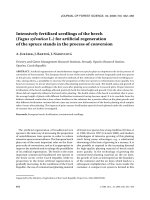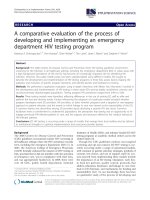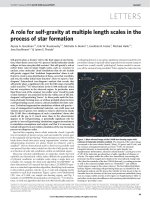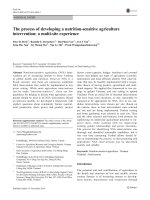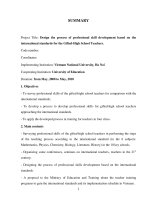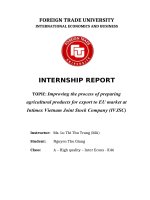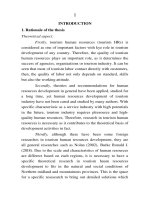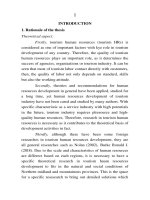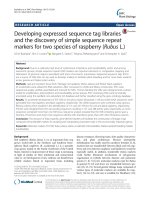THE PROCESS OF DEVELOPING AI CHATBOT SCENARIO FOR TEACHING CHEMISTRY - Full 10 điểm
Bạn đang xem bản rút gọn của tài liệu. Xem và tải ngay bản đầy đủ của tài liệu tại đây (230.69 KB, 15 trang )
PROCEEDINGS OF THE 2022 INTERNATIONAL CONFERENCE ON EDUCATIONAL TECHNOLOGY
The Process of Developing AI Chatbot Scenario
for Teaching Chemistry
Nguyen Minh Giam1, Ngo Tu Thanh2
1 , 2
Institute of Engineering Education,
Hanoi University of Science and Technology (Vietnam)
ABSTRACT
Research and analyze the definitions of AI chatbots, the basic architecture of intelligent
chatbots, international publications on the application of AI Chatbots in teaching,
through the theoretical research method as a scientific basis to perfect AI chatbots
scripting process in teaching. The focus of the study is also novelty, the author’s
new contribution is through the study of the digitization of chemical databases, the
compatibility between AI chatbots and the proposed content of chemistry teaching.
From there, the process of building AI Chatbot scenarios in teaching subjects in general
and chemistry in particular is proposed to contribute to the development of students’
self-study, self-control and self-discovery capacity. Thanks to this AI chatbot scripting
process, with a new teaching medium, the new teacher is the AI chatbot virtual assistant,
making teaching easier.
KEYWORDS: teacher, artificial intelligence, education, ai chatbot, teaching methods,
chemistry
1. Overview of AI chatbot in education
1.1. Introducing AI Chatbot
1.1.1. Artificial intelligence (AI)
AI is a branch of computer science, also known as human-programmed artificial
intelligence, so it relies on computer systems to create products with human-like
intelligence such as: learning and problem solving. The advent of AI technology
helps create great changes in the field of education. Educational activities such as
grading or teaching can be automated thanks to AI technology. Many games and
educational software were born to meet the specific needs of each student, helping
students improve their learning at their own pace (Smutny & Schreiberova, 2020).
The mention of artificial intelligence brings to mind a supercomputer, a computer
with immense processing capabilities, including adaptive behavior, such as inclusion
of sensors, and other capabilities, that enable it to have human-like cognition and
functional abilities, and indeed, which improve the supercomputers interaction with
human beings. Indeed, different motion pictures have been made to showcase the
abilities of AI, such as in smart buildings, such as the ability to manage air quality in
a building, temperatures, and or playing music depending on the sensed mood of
the occupants of the space. Within the education sector, there has been increased
application of artificial intelligence, going over and above the conventional
96
PROCEEDINGS OF THE 2022 INTERNATIONAL CONFERENCE ON EDUCATIONAL TECHNOLOGY
understanding of AI as a supercomputer to include embedded computer systems. For
example, embedded into robots, AI, or computers and supporting equipment enable
the creation of robots that improve the learning experience of the student, from the
most basic unit of education, early childhood education (Chen, Chen & Lin, 2020).
1.1.2. Artificial Intelligence in Chatbot
Artificial intelligence (AI) is a branch of computer science, also known as human-
programmed artificial intelligence, so it relies on computer systems to create
products with human-like intelligence. The underlying technologies for chatbots are
machine learning, natural language processing (NLP), and AI. NLP is the foundation
of AI based chatbots. By using NLP’s sophisticated algorithms, chatbots can process
input text: understand, conclude and determine what has been said or written and
then state a list of all the appropriate actions (Giam & Thanh, 2020).
Figure 1. Artificial Intelligence concepts in a chatbot
Natural Language Processing acts as a fundamental pillar for recognition
of language, which is used by Apple’s Siri and Google. It allows technology to
recognize human natural language text and speech-based commands and include
two major components natural language generation (NLG) and natural language
understanding (NLU)
Natural Language Understanding is responsible for handling and converting
formless data into a proper form that the system can easily understand. NLP has
further five main steps if we want that message should be easily understandable
by a chatbot. These steps are: Lexical analysis, Syntactic analysis (parsing), Semantic
analysis, Discourse integration, Pragmatic analysis.
Natural Language Generation involves text realization and text planning to
generate an understandable response. In simple words, language generation is
responsible for the formation of linguistically correct sentences and phrases. The key
challenge faced by NLP is to understand the complications of natural human language.
97
PROCEEDINGS OF THE 2022 INTERNATIONAL CONFERENCE ON EDUCATIONAL TECHNOLOGY
Automatic Speech Recognition (ASR) comes under computational linguistics,
which develops technologies and methodologies that enable the identification and
translation of user speech into text with the help of computers.
1.1.3. Fundamental Architecture of Smart Chatbot
Figure 2. General architecture of a smart chatbot
1) Environment
The place where the fundamental Natural Learning Process (NLP) engine and
context clarification occurs.
2) Questions and Answers System
It is a fundamental component to answer the users frequently asked questions.
This system understands the user’s questions properly and responds to those
questions with the related answers stored in the knowledge base.
3) Plugins/Components
Plugins provide smart chatbot automation components and chatbot solution
APIs for those chatbots which are used inside of the companies such as field worker
and HR management chatbots.
4) Node Server / Traffic Server
A server that is responsible for handling the user’s request and then route it
to the suitable components. This server also directs the response of the internal
component back to the front-end system.
98
PROCEEDINGS OF THE 2022 INTERNATIONAL CONFERENCE ON EDUCATIONAL TECHNOLOGY
5) Front-End Systems
Several systems that has a client-facing platform can be candidate to develop the
frond-end. These systems can be the chatbot interfaces that exist in many platforms.
1.1.4. Operating procedure of Chatbots
The first step of the procedure is known as receiving, in which users raise
questions, request for help, and the Chatbot receives information in the form of
natural language and proceeds to the next step. The second step is translation, in
which natural language is converted into computer language for the computer
robot to understand. This determines whether the Chatbot is smart or not. The next
step is called processing, and the Chatbot’s AI technology processes information and
searches for answers in the database. The final step is feedback, and in this step, the
Chatbot will give answers in the form of natural language messages.
1.2. Teaching AI chatbots
1.2.1 Features of Chatbot in education
AI chatbots built from teaching scenarios of subjects, lessons or courses are known
as teaching AI chatbots or virtual teachers and have the following features: Accurate
information: Instead of information exchange through word of mouth, students can
get correct answers from the school itself; Timely communication: Overall, 64% of
internet users consider 24-hour service as the best feature of a chatbot. For schools,
most of which are not available 24/7, chatbots are a way for students and parents to
get instant answers at any time; Serving multiple students at the same time: Chatbot
can answer questions of many students at the same time with endless patience;
Personal Access: A chatbot that allows you to personalize messages for each student
while sending out bulk notifications. Chatbots access and store each individual’s
learning history to provide appropriate recommendations and support for learning
(Ayanouz, Abdelhakim & Benhmed, 2020).
1.2.2 Applications of AI Chatbot in education
The first application to mention is providing information quickly and accurately.
Application to provide information such as class schedule, timetable, exam schedule,
school announcements, teachers to students in the fastest and most accurate
way. Because, the information will come directly to students without having to go
through intermediaries or word of mouth, paper announcement.
The second application is acting as an effective teaching assistant. A teacher in
a class can teach from 30 to 50 students, when imparting knowledge will be mass
for the whole class, in order to support students in the effective teaching process,
the teacher will be overloaded and will always put pressure on both teachers
and students. At this time, AI Chatbot can act as a talented and dedicated tutor
to personalize each learner. Chatbot will assist teachers in answering students’
repeated questions during lessons, courses and subjects. Chatbot also suggests and
offers appropriate learning content for each student.
99
PROCEEDINGS OF THE 2022 INTERNATIONAL CONFERENCE ON EDUCATIONAL TECHNOLOGY
The next application is acting as a chatbot learning assistant. The AI c hatbots
can assess the learning style and ability of the students to use them. In this way,
the AI C hatbot can tailor lessons for each student to help them learn more easily.
Chatbots can be used in the classroom: Chatbot can provide explanation and
support according to the needs of each student.
Out of the classroom, Chatbot can help students study and review the material
they have studied, learn, and discover more new related knowledge. In the
classroom, Chatbot can provide explanation and support according to the needs
of each student. Chatbot can also help students study and review the material they
have studied, learn, and discover more new related knowledge out of the classroom.
One major benefit to using chatbots is promoting inclusiveness in education. Not
all students learn in the same way and have the same perception, many students
cannot understand the lesson and to increase the ability to learn, it is necessary to
study one-on-one.
A common application of AI Chatbots is to create intelligent tutoring systems
that provide personalized learning environments for students by analyzing their
responses and how they go through the learning content. As a result, Chatbots with
AI technology can be brought in to teach students by passing a lecture through
a series of messages, images and videos, and assist students with the background
of the lesson as they learn. not yet stable. Chatbots continuously assess students’
understanding and offer appropriate follow-up lessons.
The last application to mention is smart and instant support. Personalizing data
in AI Chatbot, will help send notifications, tips, reminders, and motivation to each
student easily and instantly. AI Chatbot helps to answer questions instantly for
students 24/7 completely intelligently and automatically (Giam & Thanh, 2020).
2. The scientific basis of the AI chatbot scripting process
The author based on international publications on the benefits and applications
of AI Chatbot for teaching over the past 10 years in prestigious journals to perfect
the process of building AI chatbot script in teaching. In this paper, we use a group
of theoretical research methods: Research, analyze, synthesize, systematize, and
generalize theoretical documents on artificial intelligence technology, AI Chatbot,
scenarios. teaching in Vietnam and around the world, documents on innovation in
teaching methods in general and chemistry curriculum in particular.
2.1. Scenario
Scenario, as defined by the British Dictionary, is a summary of the plot of a play,
including information about characters, scenes, a predicted sequence of events; an
outline of the plot of a dramatic work of art, with specifics about scenes, characters,
situations, etc; an imagined or projected sequence of events, which can be detailed
plans or projections of any possibility.
2.2 Pedagogic Scenario (PS)
According to James Cook University (Australia), pedagogical (teaching-learning)
100
PROCEEDINGS OF THE 2022 INTERNATIONAL CONFERENCE ON EDUCATIONAL TECHNOLOGY
scenarios are created primarily to help teachers meet their expectations, allowing
learners to seek or demonstrate knowledge, skills, attitudes degree, know how
to learn. PS can take the forms: a set of instructions, case descriptions, questions,
etc., in complete or incomplete form, expressed in words, images, audio, or video,
given by a teacher to a teacher. learner; a text that outlines situations with ‘gaps’ for
students to complete on their own; a detailed summary of the roles, positions, roles
and attitudes, tasks, relationships and responsibilities of teachers and students in
the teaching-learning process.
2.3 Classification of pedagogical scenarios
There are several types of pedagogical scenarios. The teacher must choose,
decide, create a new pedagogical script suitable for his specific context, the most
important thing is that the teaching script is to facilitate effective teaching and
learning. and make it easy for learners. Pedagogical scenarios are classified according
to the following criteria:
a. Classification by form of presentation includes: Process scenario: presented in
the form of a model/drawing/diagram/process/document listing the main activities;
Specific content teaching scenario: is a scenario that contains as fully and specifically
as possible the content of all elements of the script, including: List of teaching and
learning order, specific content of step-by-step in a teacher-planned, pre-edited,
pre-edited sequence, etc.
b. Classification according to the nature of the content, the nature of the subject,
the way of teaching: Integrated teaching scenario According to professors at
Stanford University (www.stanford.edu/group/design_education), after 4 years of
researching and implementing the project on SBL, proposed a model of the stages
and activities that need to be done when you want to implement SBL to teach
thematically integrating 2 contents of technical design. technical and business, ... , in
which there are 2 stages: Building a Scenario-based learning curriculum (SBLC) with
4 pedagogical modules - Figure H1
H1 H2
Figure 3. A Scenario-based Learning Model
Organizing teaching and learning activities is the rotation of implementation
(according to H2) 4 pedagogical modules aimed at forming and consolidating in learners
the following 2 continuous learning processes: – a perception continuum and “constantly
101
PROCEEDINGS OF THE 2022 INTERNATIONAL CONFERENCE ON EDUCATIONAL TECHNOLOGY
doing” (a). processing continuum): “Continuity of perception” will help learners move from
“thinking” – the process of generalizing concepts to “feeling” on the basis of experiences.
“Continually doing”encourages students to move from the act of“Watching”– the process
of observing and reflecting on – to the action of “doing” – a positive reinforcement of the
learner experience. will form a learning preference with four characteristics: Converging,
Associating, Diverging, and Assimilation (Learning can represent “digestion”) – and this
study habit is used for other content in the course of learning the subject. In addition,
according to Karla Gutierrez, there are other types of teaching scenarios: Skill-Based
Scenario, Problem-Based Scenario, Situation-Based Scenario /Issue-Based Scenario),
Speculative Scenario, Game-Based Scenario (Gaming Scenario).
2.4. The meaning of the teaching scenario
In all contexts, the pedagogical scenario (teaching - learning) is always important
and irreplaceable because of the benefits it brings to both learners, teachers, and
administrators. For learners, to learn and know how to self-study, self-assess, evaluate
each other in a humane and scientific way to: Forming core humanistic competencies
and qualities; developing high-level competencies. It doesn’t take much time for the
transition from school knowledge and skills to be applied to what you need/should
do in your career and life in the future. For teachers and educational administrators,
a detailed teaching script helps. Teachers do not omit content (even to each word) -
maintain a balance in teaching-learning quality in other types of training and training
spaces. together; Organize interactive, diverse and rich teaching and learning, helping
learners know how to learn the subject; Achieving a balance in the evaluation of
training quality of the three parties School-Society-Employer; Reducing pedagogical
labor pressure, saving pedagogical labor time in updating and renovating teaching
contents and methods, following the general trend (or regulations). A good teaching
scenario helps: The coordination between teaching and learning labor is in the
right direction of pedagogical goals; Shorten the training time for the next class of
lecturers; Teachers continuously improve and improve the quality of pedagogical
workers according to TQM (Total Quality Management); Quickly change the method
of teaching organization while still ensuring the quality of training (Dung, 2020).
3. Innovating teaching methods
Over the past few years, along with the appeal of instant messaging, chatbots
and pedagogical agents have pushed educators to integrate messaging tools in
teaching and learning. Compared with current teaching methods, current students
enjoy interacting through messaging and exchanging information through chat
applications. Grasping this “taste”, the application of Chatbot in teaching is a new
step, bringing effective teaching and improving the quality of teaching and learning.
Teaching through AI Chatbot provides answers, instant support and personalization
creating a more engaging learning experience, promoting positivity, initiative,
creativity and enhancing self-learning ability for students. Teachers who teach
through teaching methods without applying technology will take a lot of time and
effort. AI Chatbot that is both an assistant for teachers and an assistant for students
will make the teaching process easier than ever (Giam & Thanh, 2020).
102
PROCEEDINGS OF THE 2022 INTERNATIONAL CONFERENCE ON EDUCATIONAL TECHNOLOGY
4. AI Chatbot scenario building process
4.1. Definition
AI chatbot scenario is a pedagogical scenario built to teach on AI chatbot with
teaching content transmitted to students through a virtual teacher, which is an AI
chatbot to improve students’ self-learning ability and improve self-learning ability.
high quality teaching.
4.2. AI Chatbot scenario constructing process
The process of building AI chatbot scenario to demonstrate through the following
steps:
Figure 4. AI Chatbot scenario constructing process
Step 1: Determining the structure of the scenario
First, we need to Ddefinineg teaching goals and preparate, select resources
related to the lesson, subject. Second, we anticipate quotes, situational sentences,
interactive questions, test exercises and teaching - learning - assessment - feedback
strategies. Then we structure the teaching script in the direction of personalized
learners and finally select AI chatbot suitable for the teaching scenario. Based on
the objectives of the subject and the curriculum, use the course outline to build
a teaching scenario. Determine the arrangement of the content and organize the
content within the teaching script to meet the goals of skills and attitudes, and how
to implement and evaluate the content. This teaching script can be changed and
adjusted to suit many learning objects such as each, subject, class or each course.
103
PROCEEDINGS OF THE 2022 INTERNATIONAL CONFERENCE ON EDUCATIONAL TECHNOLOGY
Step 2: Constructing scenario content
The development of a scenario for a lesson needs to ensure that the contents
of the teaching program are fully individualized, helping students to learn by
themselves and acquire knowledge in the most effective way. In each step of the
script, the content must always be strictly, scientifically and accurately controlled. A
teaching script consists of 3 parts:
Heading: Focusing on the general overview and content structure will be
presented such as: Introduction to the content overview, concepts, issues to be
discussed, quotes from practice to enter the concepts and theory included in the
lecture. Focusing on the general overview and content structure will be presented
such as: Introduction to the content overview, concepts, issues to be discussed,
quotes from practice to enter the concepts and theory included in the lecture.
Development section: In this part, focus on the core content and the expanded
content of the lesson: Explain concepts, definitions, properties, how to apply, give
illustrative examples, pictures, videos... give extended cases, exercises, solve sample
exercises… Develop skills, attitudes and awareness for students. In this part, focus
on the core content and the expanded content of the lesson: Explain concepts,
definitions, properties, how to apply, give illustrative examples, pictures, videos...
give extended cases, exercises, solve sample exercises. Develop skills, attitudes and
awareness for students.
The end: This part is the part that emphasizes the main content of the lecture,
tells learners the end and results of the teaching process, as well as shows the
purpose and ultimate meaning of the lesson content. From there to remind, assign
exercises and apply the lesson in practice at the end of the lesson. This part is the
part that emphasizes the main content of the lecture, tells learners the end and
results of the teaching process, as well as shows the purpose and ultimate meaning
of the lesson content. From there to remind, assign exercises and apply the lesson in
practice at the end of the lesson.
Step 3: Submitting the scenario to AI chatbot
Before putting the teaching script on AI chatbot, it is necessary to divide and
digitize the script to be compatible with AI chatbot, also known as building a
database for AI chatbot. Submitting each scenario content to the AI c hatbot must
follow the correct sequence of the script structure and the scenario built in step 1
and step 2. At the same time, adding background knowledge for each content in the
above teaching scenario for AI chatbot (conjectured and built by the teacher) when
students need it, the lookup will be answered immediately. This is very important,
very useful and characteristic feature of AI chatbot.
Step 4: Testing and teaching
After uploading the teaching script to the AI c hatbot (bot), we will have a virtual
teacher who teaches the content according to the previously built teaching scenarios.
At this point, we need to check the (intelligent) operation of the AI c hatbot by asking
the bot (entering random content in the teaching scenario) to see if the bot answers
104
PROCEEDINGS OF THE 2022 INTERNATIONAL CONFERENCE ON EDUCATIONAL TECHNOLOGY
correctly, completely and correctly. If not, we re-check the entire digitization process and
put the built-in teaching scenario data to make appropriate changes and corrections.
The process of checking until the bot is proficient (intelligent) then stops. After testing
the bot, we conduct teaching - learning many times before going into formal teaching
to detect mistakes to adjust and at the same time accumulate and add new knowledge
for AI chatbot to Bots are getting smarter and smarter. This is the step to test the
qualifications of virtual teachers before conducting “contracting” for formal teaching.
Step 5: Assessments
Evaluating teaching scenarios is also assessing the teaching quality and
effectiveness of AI chatbots to improve scenarios, adjust, and improve the quality
and effectiveness of teaching.
5. The process of building Ai chatbot scenarios in teaching chemistry
5.1. Location and characteristics of chemistry
Chemistry - is the study of the composition, structure, properties, and changes
of matter, elements, compounds, atoms, molecules, and the chemical reactions that
occur between those components .
Theory with experiment is the basic feature of Chemistry. Chemistry gives students
vivid scientific knowledge, helping us to explain many interesting phenomena in
nature and in everyday life. Chemistry also helps students practice and improve
themselves essential skills such as: observation, judgment, comparison, analysis,
etc., bringing passion to the students for this subject (Giam, 2015).
5.2. Aims and content of chemistry
5.2.1. Aims of chemistry
The educational objective of Chemistry is to form and develop in students chemical
competence; at the same time, contributing together with other educational subjects
and activities to form and develop in students the main qualities and common
competencies, especially the scientific worldview; interest in learning and research;
honesty; respectful attitude respect the laws of nature, behave with nature in accordance
with the requirements of sustainable development; the ability to choose a career in
accordance with their own capacity and interests, conditions and circumstances.
5.2.2. Content
The content of Chemistry is designed into topics that both ensure to strengthen
the content circuits, develop knowledge and practical skills, and help students have
a deeper understanding of the general basic knowledge of chemistry. , as a basis
for studying, working and researching. Chemistry curriculum with 3 core content
circuits: General basic knowledge of chemistry; inorganic chemistry and organic
chemistry. The main development axis of the Chemistry program is the system of basic
chemical knowledge about the structure of substances and the process of chemical
transformation. Knowledge of the structure of atoms, chemical bonds, chemical energy,
rate of chemical reactions, redox reactions, balance by chemistry, electric batteries
105
PROCEEDINGS OF THE 2022 INTERNATIONAL CONFERENCE ON EDUCATIONAL TECHNOLOGY
and electrolysis, the periodic table of chemical elements is the main theoretical basis
for students to explain the nature and study the laws of chemistry in the contents of
inorganic chemistry and chemistry. organic chemistry to a certain extent.
5.2.3. The most outstanding new features of the Chemistry program
The most important new point in the Chemistry curriculum is the emphasis
on practicality; avoid a computational bias; Focusing on equipping tools with
concepts and methods of using tools, especially helping students to have practical
experimental skills, skills to apply chemical knowledge in understanding and
solving at high level. certain problems of practice, meeting the requirements of life
(Training, 2018).
5.3. Methods and means of teaching chemistry
5.3.1. Methods of teaching
Most high schools use chalkboards and textbooks in the teaching process.
These means are still not enough for teachers to transmit knowledge to students,
so it is necessary to design teaching media suitable for students, with the school’s
conditions and to respond immediately and immediately to the process. Effective
teaching is very important and necessary.
5.3.2. Teaching tool
The innovation of chemistry teaching methods in the direction of competence
is the focus of the program. The Chemistry curriculum pays special attention to the
orientation of capacity development through the design of teaching activities for
each learning content and topic. Educational methods are mainly selected according
to the following orientations:
Activity orientation: Students’ learning activities are based on experiential
activities; Applying, connecting with practice and orienting to solve practical
problems to enhance students’interest, contribute to the formation and development
of the quality and capacity of the students that the subject is responsible for.
Positive teaching orientation: Increase the use of teaching methods to promote
positivity, initiative, creativity and suitability with the formation and development
of qualities and capacities for learners. practice, experience in teaching contents,
especially when studying inorganic and organic substances, which have many
practical applications through learning projects.
Combining STEM education: develop students’ ability to integrate knowledge
and skills of Math - Engineering - Technology and Chemistry subjects into research
to solve some real-life situations. Use chemistry exercises that require critical and
creative thinking (open exercises, multiple solutions,...), exercises with practical
content, enhancing the nature of chemistry, and reducing problems. Mathematical
calculation exercises.
Diversify learning forms: use information technology and teaching devices
appropriately and effectively in teaching chemistry (Training, 2018).
106
PROCEEDINGS OF THE 2022 INTERNATIONAL CONFERENCE ON EDUCATIONAL TECHNOLOGY
5.4. The process of constructing AI chatbot scenario in teaching chemistry
From the location, characteristics of chemistry, and the benefits of AI Chatbot,
researchers found that AI Chatbot integrated with a chemistry teaching scenario
is very suitable to easily achieve the goal of teaching, improving High efficiency
in teaching and learning Chemistry. The AI chatbot scenario process in teaching
chemistry is built based on the AI chatbot scripting process:
Step 1: Define the structure of the script
First, it is needed to determine the goals of teaching chemistry, prepare and select
resources related to the lessons in the chemistry program. We also need to predict
quotes, situational sentences, interactive questions, test exercises and teaching -
learning - assessment - feedback strategies, structuring chemistry teaching scenarios
towards individualization of learners. and choose the AI chatbot platform: fpt.ai for
the chemistry teaching scenario.
Step 2: Constructing scenario content
Building a scenario for a lesson or a whole chemistry program according to the
amount of knowledge from basic to advanced to serve each student’s level and
individual level. Later graders can relearn previous grade chemistry knowledge
to regain old knowledge, background knowledge whenever they need it right
on AI chatbot. Pretty good students can self-add more advanced and specialized
knowledge.
Natural Language Processing is a core AI feature of the FPT.AI Conversation
platform. In order for the Bot to be able to understand the students’ sentences, the
teacher designing the bot needs to teach the bot a specific amount of knowledge
according to the content of each lesson in chemistry. In FPT.AI, the scenario (Scenario)
is a topic that the bot relies on to answer students. Step (Step) is a sub-topic. A script
consists of several steps with the same topic. These steps can be linked together by
buttons. The design of scenarios that answer each intent. With the intention that the
sample sentence contains no entities, the Bot only needs to give a single answer.
However, with the intention that the sample sentence contains an object entity, the
Bot needs to give different answers based on that entity. In this case, we use the
condition of the variable.
Heading: Introduction of overview content, concepts, issues to be discussed,
quotes from practice to enter concepts and theories contained in chemistry lectures
by steps and suggested content buttons for students to choose from.
Development section: Build concepts, definitions, physical properties, chemical
properties of substances by steps, in the steps will be nodes containing the content
of concepts, reaction phenomena, how to apply Use, give illustrative examples, relate
to real life in the form of writing, images or videos...; Experiment: Digitize chemical
lab experiments into images and videos. In this section, the steps will be steps in the
experiment such as: preparation, safety, conduct ..., each step will include buttons
containing small contents in each step of the experiment; Exercises: Each step is an
exercise, solving sample exercises, exercises go from easy to advanced. The buttons
107
PROCEEDINGS OF THE 2022 INTERNATIONAL CONFERENCE ON EDUCATIONAL TECHNOLOGY
will be answer options or suggestions or move to the next sentence. To develop
students’ skills, attitudes and awareness.
The end: Develop key steps of the lesson such as: Concepts, physical properties,
chemical properties and practical applications, assign homework.
For the most logical scenario design, describe the sub-scenarios and divide them
into conversation flows in the form of a tree map.
Step 3: Submitting the scenario to AI chatbot
Create scenario flow for Chatbot: Break down and digitize each teaching content
in a chemistry lecture by step 1 and step 2 into small topics according to Sample
Sentences (Questions that learners use to ask about problems they need answers
to). From there, what is the intention (purpose, intent of the questions) of the
learners in each sub-topic? At the same time, build Keywords (The important and
necessary information in the sentence, helping the bot understand the problem that
the learner is talking about to give a suitable answer). Building the Entity (Denoting
the meaning of the above Keywords) in the Sample Sentences (Sample), the set of
Sample Sentences (Sample) is the sentence that learners will ask related to each
problem to teach the bot.
Table 1. Example about scenario for Chatbot
Sample sentence: I want to solve exercise 2, Key words Entity Type
8th grade chemistry, page 30 2 Number exercise
Intent
Chemistry Subject
Solving exercise 8th grade Class
Page 30 Page
Sample sentences are very important for chatbots. Therefore, teachers should
add as many sample sentences as possible. The variety of sample sentences will help
the chatbot to understand many different sentences of learners.
The Intents that are of most interest to users should be identified based on the
learners’ experiences as well as questions, queries, or chat history. Then add as many
and varied sample sentences to those intentions. Submitting each scenario content
to the AI c hatbot must follow the correct sequence of the script structure and the
scenario built in step 1 and step 2. At the same time, add background knowledge
such as reaction equations, valency, formulas, chemical formulas for each content
in the above teaching scenario for AI chatbot (as guessed by the teacher. and
construction) when students need it, the lookup will be answered immediately. This
is very important, very useful and characteristic feature of AI chatbot.
Step 4: Testing and teaching
Test the bot’s intelligence by asking the bot random questions about valence,
chemical properties, formula or chemical equations and see how accurate the
108
PROCEEDINGS OF THE 2022 INTERNATIONAL CONFERENCE ON EDUCATIONAL TECHNOLOGY
bot is when answering. Check for errors and fix them from the digitization step to
the final step of putting the teaching script on the bot until the accuracy is 100%,
then conduct a trial lesson. The trial teaching many times before going into formal
teaching to detect mistakes to adjust and at the same time accumulate and add new
knowledge for AI chatbot so that the Bot gets smarter and smarter.
Step 5: Assessments
Evaluating the quality and effectiveness of AI chatbot teaching chemistry
through achieving the goal of teaching chemistry, thereby improving the scenario,
adjusting, and improving the quality and effectiveness of teaching.
6. Results
In teaching, AI Chatbot aims to personalize learners and can support many
students at the same time 24/7 that real teachers cannot. With the usefulness of AI
Chatbot that is perseverance and persistence, students can ask the same question
over and over again until they understand it without being shy like asking a real
teacher. Teachers often only hear and see what students say, directly understanding to
some extent. Teachers cannot fully understand the difficulties that most students are
facing. With AI Chatbot, teachers can view chat (learning) history, to assess students’
learning ability so that appropriate support can be given to each student to improve
quality and efficiency. teaching in general and self-study in particular. In this article,
authors research and present the process of building AI Chatbot Scenario for teaching
in general and chemistry in particular. AI Chatbot script is the soul of AI Chatbot to
use in the process of teaching chemistry. From the AI Chatbot scenario, we continue
to research and have perfected the process of teaching chemistry using AI Chatbot
with the following steps: defining goals, determining learning content, logging in
to the system, learning with virtual assistant, test, control, evaluate and support.
The teaching method we apply here is mainly interactive teaching method. We will
publish this research content in international peer-reviewed journals and conferences.
7. Conclusion
With the great benefits of AI chatbot in education, teaching is now easier with a
new teaching tool, the new teacher is the AI chatbot virtual assistant. Script is the
soul of AI Chatbot, building a script for AI chatbot is very important, it determines
the intelligence and teaching effectiveness of AI chatbot.
From the AI C hatbot scenario that has been built, we apply the process of using
AI Chatbot to teach chemistry and conduct teaching through interacting with
the virtual assistant using the “Learning Box” (the Learning Box is the interface).
interactive message interface between learners and AI Chatbot. Here, it will display
all the students’ interactive learning actions and the answers of the virtual assistant
- AI Chatbot) by entering internal keywords. learning content, virtual teachers will
provide buttons and learning steps for students to learn, in the process of learning,
taking tests, students do not understand, do not remember background knowledge
such as: chemical formulas, reaction equations, elements, atomic molar masses...
will be answered by the virtual teacher immediately so that students can continue
109
PROCEEDINGS OF THE 2022 INTERNATIONAL CONFERENCE ON EDUCATIONAL TECHNOLOGY
to complete the lesson according to the chemistry teaching scenario. Through the
student’s learning history in the “learning box” teachers can check, control and
evaluate to have support for each specific student.
Chemistry is a subject with logical and complementary knowledge, so the
application of teaching chemistry through AI Chatbot is appropriate and improves
teaching efficiency and quality, and develops self-study capacity for students.
students, it is necessary to pay attention to, build and replicate this model in teaching
activities to expand it to many other subjects.
In the research in this article, we provide a process to build a common teaching
AI Chatbot scenario for all subjects and lessons. Through that, we verified by
building the scenario of AI Chatbot day to learn chemistry. This will be the premise
and theoretical basis for further extensive studies on the application of intellectual
technology in education. In terms of limitations in this study, we have not clearly
outlined the teaching process using AI Chatbot, but only reviewed some of the
content in this process. Research on the teaching process using AI Chatbot and
verification through teaching chemistry will be published in the next study.
References
Ayanouz, S., Abdelhakim, B. A., & Benhmed, M. (2020). A smart chatbot architecture
based NLP and machine learning for health care assistance. International
Conference on Networking (pp. 1-6). Information Systems & Security.
Chen, L., Chen, P., & Lin, Z. (2020). Artificial intelligence in education: A review. IEEE
Access, 75264-75278.
Dung, N. (2020). Developing a solid script and implementing effective instruction
following a well-prepared scenario for successful execution of Electronic/Mobile
Learning. HCMC University of Technology and Education.
Elwell-Chalmers, S. (2019). Effects of scenario-based learning on motivation
and performance: a case study of multiunit managers in a Fortune 500 retail
organization. The Doctoral dissertation, Colorado State University.
Giam, N. (2015). Optimizing teaching methods for 12th-grade Chemistry at the
Continuing Education Center in Binh Duong province.HCMC University of Technology
and Education.
Giam, N., & Thanh, N. (2020). AI Chatbot application innovates teaching methods.
Thiet Bi Giao Duc.
Smutny, P., & Schreiberova, P. (2020). Chatbots for learning: A review of educational
chatbots for the Facebook Messenger. Computers & Education, 151.
MOET (2018). New General Education Program: Understanding the Chemistry
Curriculum. Retrieved from />
110
